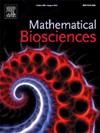通过降阶模型和神经网络对胶质母细胞瘤生长的患者特异性预测
IF 1.8
4区 数学
Q2 BIOLOGY
引用次数: 0
摘要
胶质母细胞瘤是成人中最具侵袭性的脑肿瘤之一,其特点是由潜在的大脑微观结构驱动的患者特异性侵袭模式。在这项工作中,我们提出了GBL生长的数学模型的概念验证,能够从纵向神经成像数据中进行实时预测和患者特定参数识别。该框架利用扩散界面数学模型来描述肿瘤的演变,并采用降阶建模策略,该策略依赖于适当的正交分解,并根据磁共振成像和扩散张量成像重建的患者特定脑解剖结构的合成数据进行训练。神经网络代理学习从肿瘤进化到模型参数的逆映射,在保持高精度的同时实现了显著的计算速度提升。为了确保鲁棒性和可解释性,我们进行了全局和局部敏感性分析,确定了控制肿瘤动力学的关键生物物理参数,并评估了反问题解决方案的稳定性。这些结果为未来在神经肿瘤学中临床部署患者特异性数字双胞胎奠定了方法学基础。本文章由计算机程序翻译,如有差异,请以英文原文为准。
Patient-specific prediction of glioblastoma growth via reduced order modeling and neural networks
Glioblastoma is among the most aggressive brain tumors in adults, characterized by patient-specific invasion patterns driven by the underlying brain microstructure. In this work, we present a proof-of-concept for a mathematical model of GBL growth, enabling real-time prediction and patient-specific parameter identification from longitudinal neuroimaging data.
The framework exploits a diffuse-interface mathematical model to describe the tumor evolution and a reduced-order modeling strategy, relying on proper orthogonal decomposition, trained on synthetic data derived from patient-specific brain anatomies reconstructed from magnetic resonance imaging and diffusion tensor imaging. A neural network surrogate learns the inverse mapping from tumor evolution to model parameters, achieving significant computational speed-up while preserving high accuracy.
To ensure robustness and interpretability, we perform both global and local sensitivity analyses, identifying the key biophysical parameters governing tumor dynamics and assessing the stability of the inverse problem solution. These results establish a methodological foundation for future clinical deployment of patient-specific digital twins in neuro-oncology.
求助全文
通过发布文献求助,成功后即可免费获取论文全文。
去求助
来源期刊

Mathematical Biosciences
生物-生物学
CiteScore
7.50
自引率
2.30%
发文量
67
审稿时长
18 days
期刊介绍:
Mathematical Biosciences publishes work providing new concepts or new understanding of biological systems using mathematical models, or methodological articles likely to find application to multiple biological systems. Papers are expected to present a major research finding of broad significance for the biological sciences, or mathematical biology. Mathematical Biosciences welcomes original research articles, letters, reviews and perspectives.
 求助内容:
求助内容: 应助结果提醒方式:
应助结果提醒方式:


